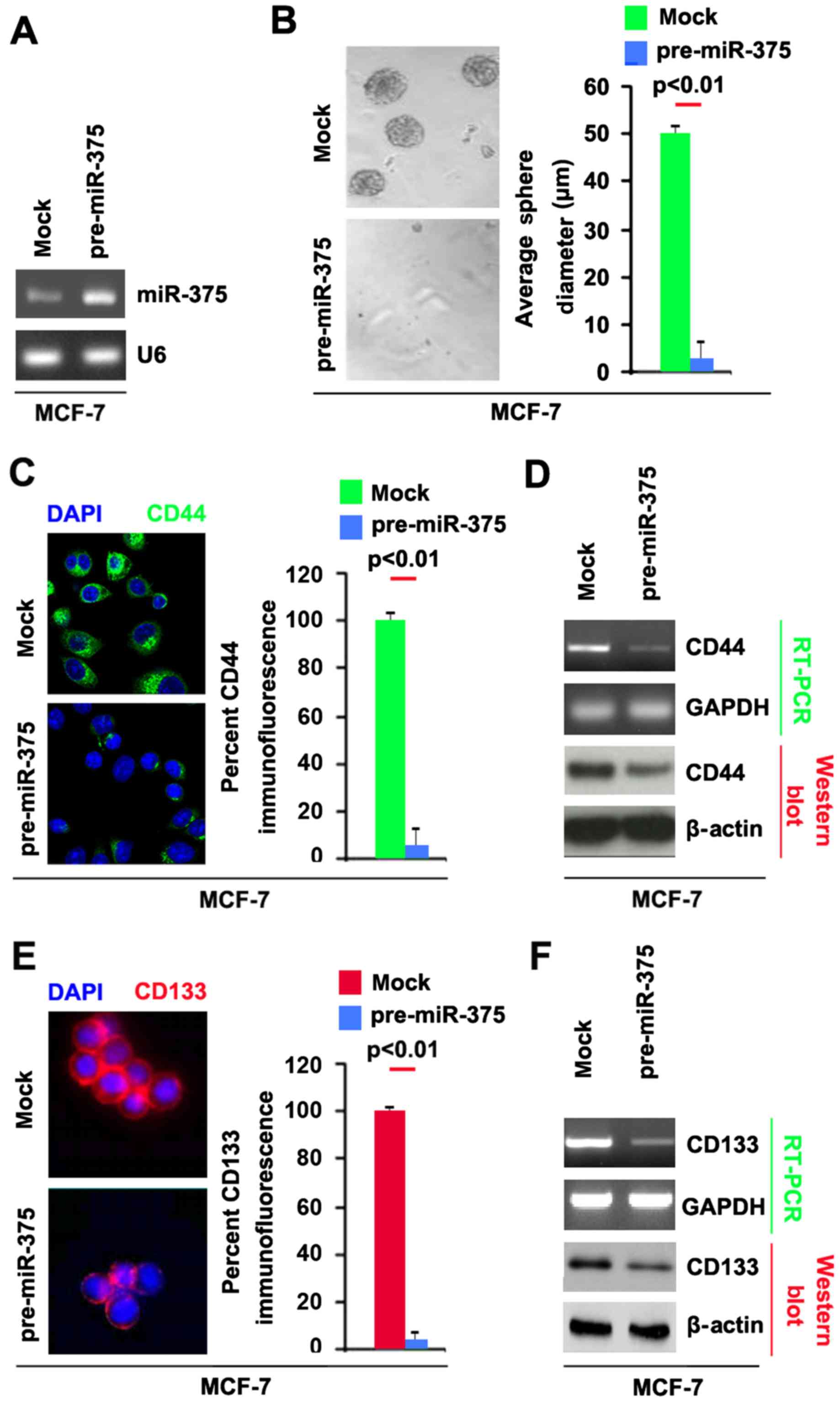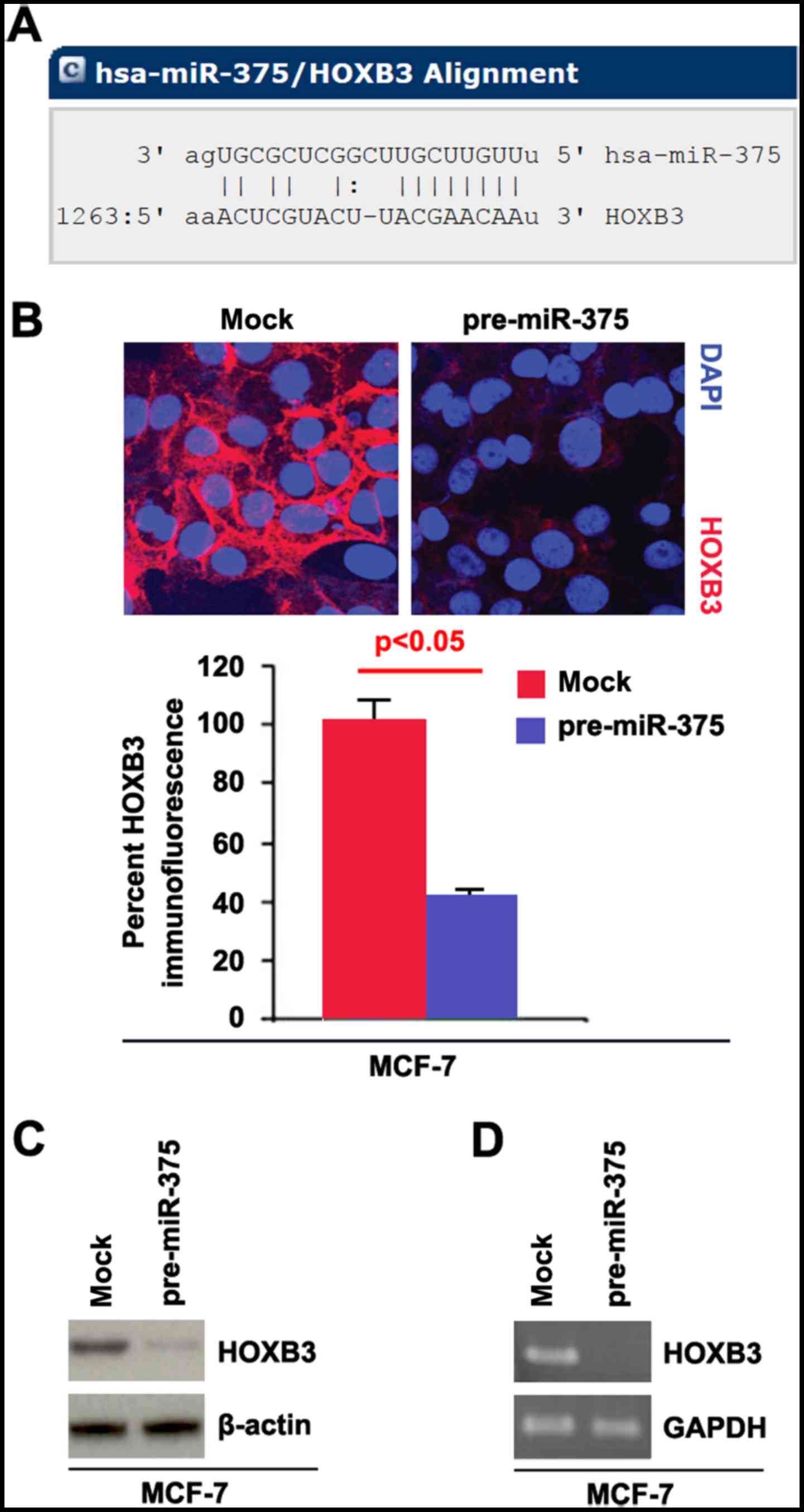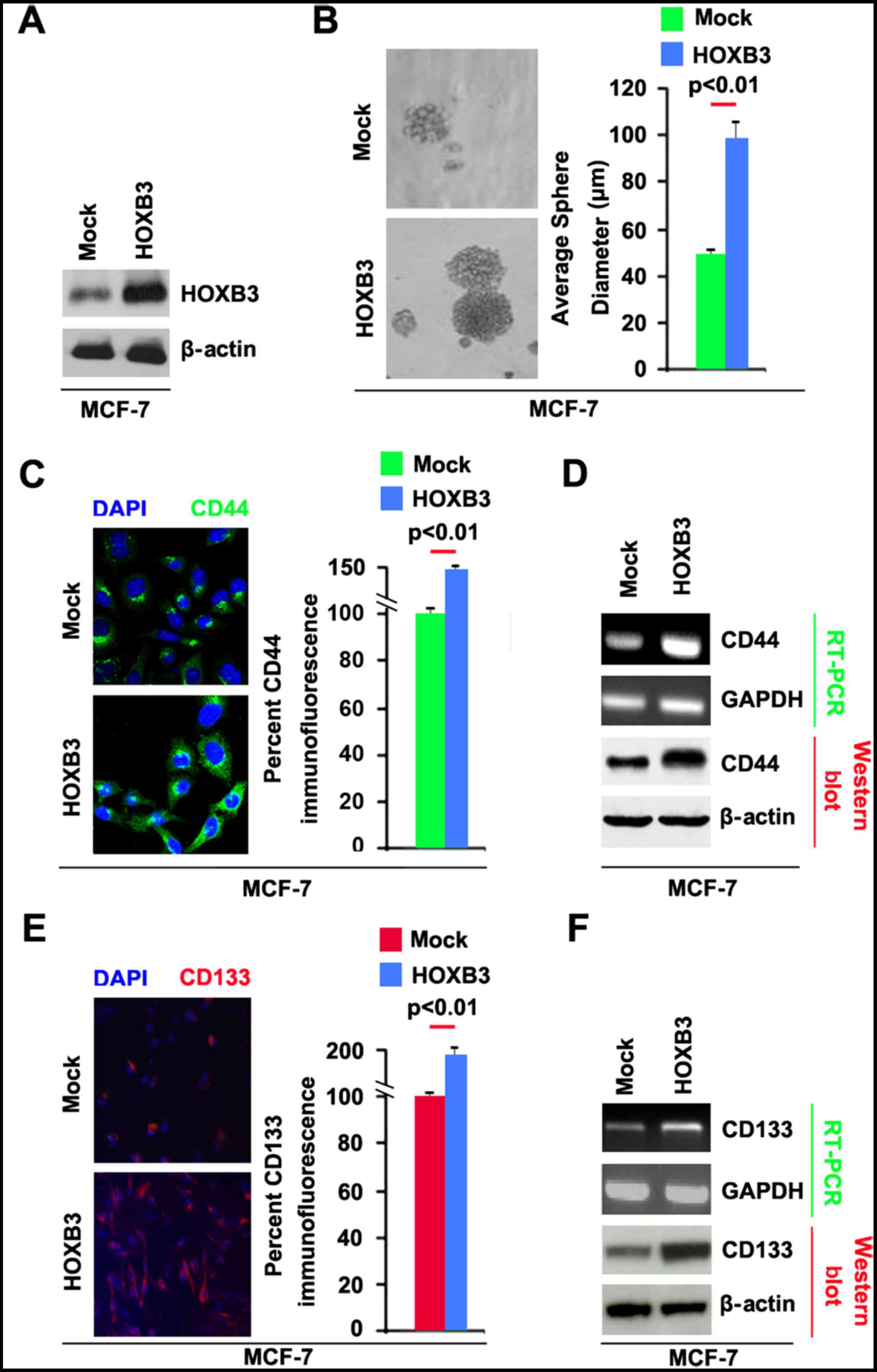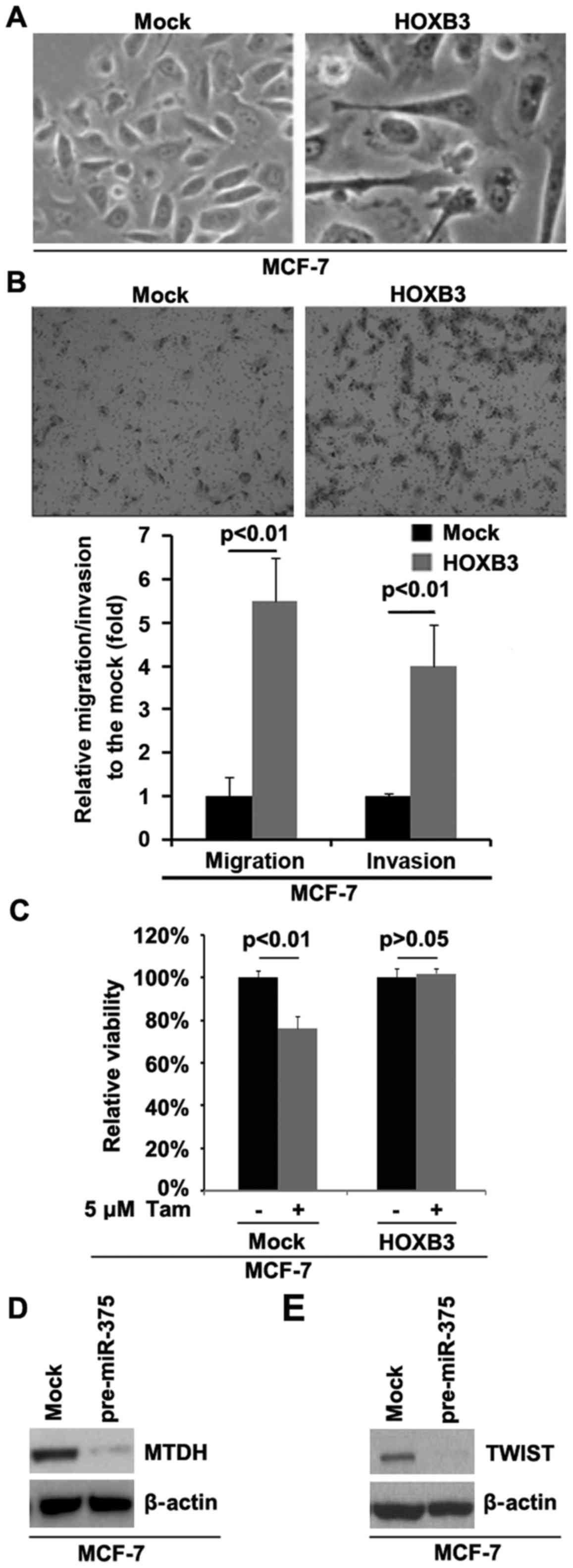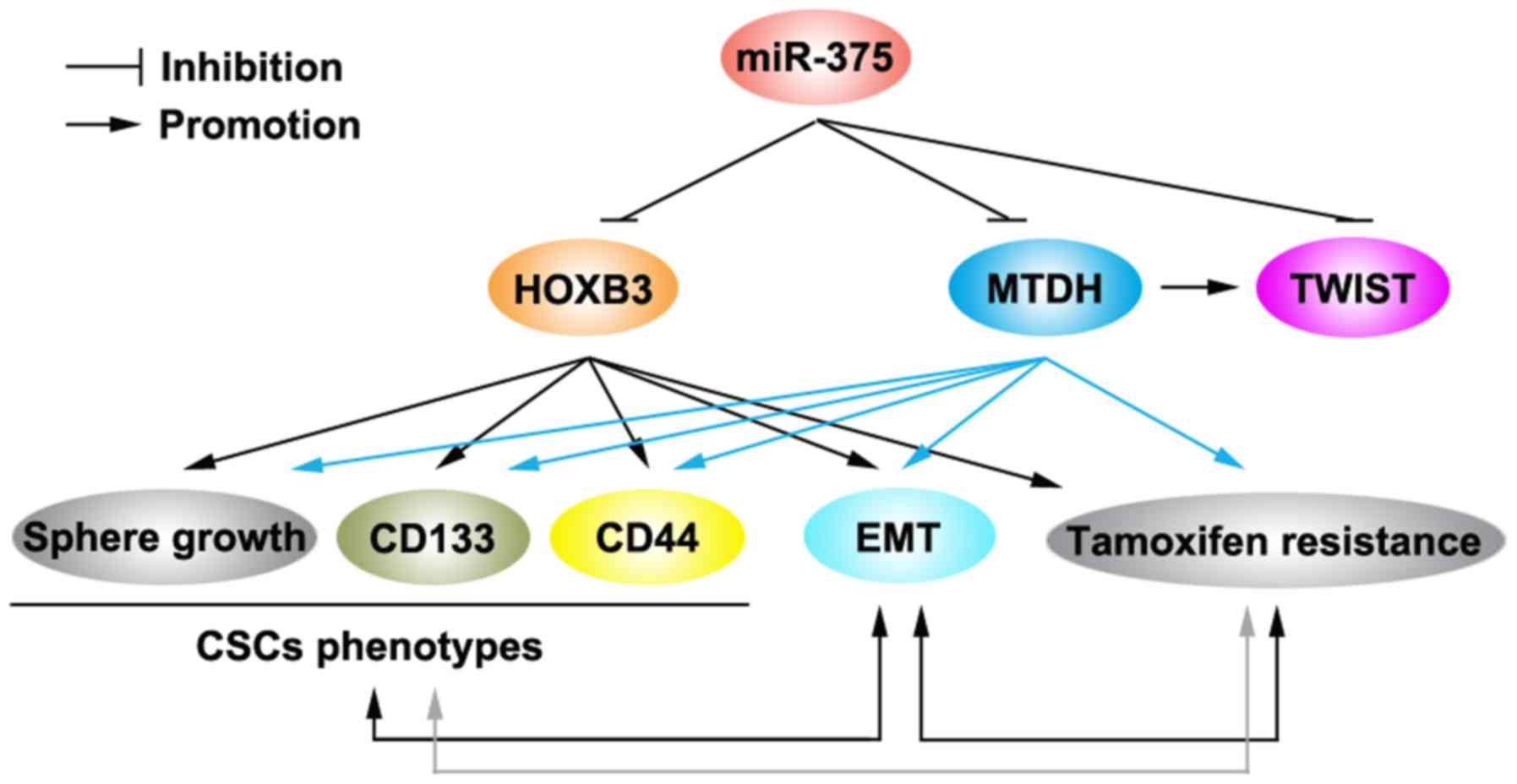miR-375 inhibits cancer stem cell phenotype and tamoxifen resistance by degrading HOXB3 in human ER-positive breast cancer
- Authors:
- Published online on: January 9, 2017 https://doi.org/10.3892/or.2017.5360
- Pages: 1093-1099
Abstract
Introduction
Approximately 60–70% of breast cancer express estrogen receptor α (ERα) and (or) progesterone receptor and merit the use of hormone therapies, such as the estrogen receptor antagonist tamoxifen (1). Use of tamoxifen has improved outcomes for patients with ER+ breast cancer, but in 40–50% of these patients the cancers recur, usually as distant metastasis, and the majority of these patients will die of the metastasis (2). One possible explanation for the initial positive response to therapy followed by drug-resistance is that current therapies eliminate the bulk of the tumour, but they fail to eliminate cancer stem cells (CSCs). Thus, studying molecular mechanism underlying the formation of CSCs and the link between CSCs and tamoxifen-resistance will help us to offer new molecular targets for effective therapies.
Emerging evidence suggests a strong link between resistance to therapies and the induction of epithelial-mesenchymal transition (EMT) in cancer (3). Morphologically, EMT is characterized by the loss of tight cell-cell junctions and accompanied by re-organization of the actin cytoskeleton, resulting in spindle shaped mesenchymal-like cells, which are capable of migrating and invading other tissues (4). Determining the mechanisms that connect EMT and the development of drug resistance could be a key approach for the development of novel therapeutic strategies to overcome both drug resistance and potentially prevent metastasis initiation.
MicroRNAs (miRs) are small non-coding RNAs that modulate protein expression by binding to complementary or partially complementary the 3-untranslated region (UTR) of target mRNAs and thereby targeting the mRNA for degradation or translational inhibition (5,6). Recently, it has been reported that miRNA-375 was among the top downregulated miRNAs in tamoxifen-resistant cells (7). Re-expression of miR-375 was sufficient to sensitize tamoxifen-resistant cells to tamoxifen and partly reversed EMT (7). Thus, restoration of miR-375 might serve as a potential therapeutic approach for the treatment of tamoxifen-resistant breast cancer.
In the present study, we showed that miR-375 inhibits CSC traits in breast cancer MCF-7 cells. Bioinformatics analysis and experimental validation identified HOXB3 as a direct target of miR-375. Overexpressing miR-375 degraded HOXB3 mRNA in MCF-7 cells. Moreover, overexpression of HOXB3 induced formation of CSC phenotypes, EMT and tamoxifen-resistance as well as enhanced ability of migration and invasion in MCF-7 cells. Most ER-positive breast cancer-related deaths occur because of resistance to standard therapies and metastasis, restoring miR-375 or targeting HOXB3 might serve as potential therapeutic approaches for the treatment of tamoxifen-resistant breast cancer.
Materials and methods
Breast cancer MCF-7 cell line, HOXB3 expressing plasmids/empty vectors, pre-miR-375/control miR and transfection
Human breast cancer cell line MCF-7 was obtained from the American Type Culture Collection (ATCC; Manassas, VA, USA). Briefly, cells were maintained in RPMI-1640 medium supplemented with 10% fetal bovine serum (FBS; Gibco, Grand Island, NY, USA) and penicillin/streptomycin at 37°C in a humidified atmosphere with 5% CO2. HOXB3 expressing plasmids/empty vectors (pcDNA3.1) were purchased from Tiangen Biotech, Co., Ltd. (Beijing, China). pre-miR-375/control miR were purchased from Ambion, Inc. (Austin, TX, USA). For transfection experiments, the cells were cultured in serum-free medium without antibiotics at 60% confluence for 24 h, and then transfected with transfection reagent (Lipofectamine 2000; Invitrogen, Carlsbad, CA, USA) according to the manufacturers instructions. After incubation for 6 h, the medium was removed and replaced with normal culture medium for 48 h, unless otherwise specified.
Western blot analysis
Western blot analysis was performed as previously described (8). Briefly, after incubation with primary antibody anti-CD44 (1:500; Abcam, Cambridge, MA, USA), anti-CD133 (1:500; Abcam), anti-HOXB3 (1:500; Abcam), anti-MTDH (1:500; Abcam), anti-TWIST (1:500; Abcam) and anti-β-actin (1:500; Abcam) overnight at 4°C, IRDye™-800 conjugated anti-rabbit secondary antibodies (LI-COR Biosciences, Lincoln, NE, USA) were used for 30 min at room temperature. The specific proteins were visualized by Odyssey™ Infrared Imaging System (Gene Co., Lincoln, NE, USA).
Sphere formation assay
Cells (103/ml) in serum-free RPMI-1640/1 mM Na-pyruvate were seeded on 0.5% agar precoated 6-well plates. After 1 week, half the medium was changed every third day. Single spheres were picked and counted.
Immunostaining assay for CD44 and CD133 in breast cancer spheres
Single cell suspensions of MCF-7 cells transfected as indicated were prepared and plated using ultra low adherent wells of 6-well plate at 5,000 cells/well in sphere formation medium, as described above. After 7 days of treatment, the breast cancer spheres were collected by centrifugation, washed with 1X phosphate-buffered saline (PBS) and fixed with 3.7% parformaldehyde for immunofluorescence staining, as described previously by our laboratory. Coverslips were counterstained with DAPI (Invitrogen-Molecular Probes, Eugene, OR, USA) for visualization of the nuclei. Microscopic analysis was performed with a confocal laser scanning microscope (Leica Microsystems, Bensheim, Germany). Fluorescence intensities were measured in a few viewing areas for 300 cells per coverslip and analyzed using ImageJ 1.37v software (http://rsb.info.nih.gov/ij/index.html).
Immunofluorescence analyses for HOXB3 in MCF-7 cells
For immunofluorescence analyses, MCF-7 cells were plated on glass coverslips in 6-well plates and transfected as indicated. At 48 h after transfection, coverslips were stained with HOXB3 (1:500; Abcam) Alexa Fluor 488 goat anti-rabbit IgG antibody was used as secondary antibody (Invitrogen). Similarly to the above, the coverslips were counterstained with DAPI (Invitrogen-Molecular Probes) for visualization of the nuclei. Microscopic analysis was performed with a confocal laser-scanning microscope (Leica Microsystems). Fluorescence intensities were measured in a few viewing areas for 300 cells per coverslip and analyzed using ImageJ 1.37v software (http://rsb.info.nih.gov/ij/index.html).
Migration and invasion assay
Migration and invasion assay was performed as described before (8).
Methods of bioinformatics
The analysis of potential microRNA target site using the commonly used prediction algorithms, miRanda (http://www.microrna.org/).
Real-time PCR for microRNAs
Total RNA from cultured cells, with efficient recovery of small RNAs, was isolated using the mirVana miRNA isolation kit (Ambion). Detection of the mature form of miRNAs was performed using the mirVana qRT-PCR miRNA detection kit and qRT-PCR Primer Sets, according to the manufacturers instructions (Ambion). The U6 small nuclear RNA was used as an internal control.
Reverse transcription-polymerase chain reaction
RT-PCR was performed as described (9). Primers for CD44: forward, 5-GGATGGGCGGATGGAAGGAT-3 and reverse, 5-TCCGCTGGGCAATGAGGCTG-3. Primers for CD133: forward, 5-CACTCTATACCAAAGCGTCAA-3 and reverse, 5-CACGATGCCACTTTCTCAC-3. Primers for GAPDH: forward, 5-CGGAGTCAACGGATTTGGTCGTAT-3 and reverse, 5-AGCCTTCTCCATGGTGGTGAAGAC-3.
MTT assay
The effect of the cell proliferation was assessed by 3-(4,5-dimethylthiazol-2-yl)-2,5-diphenyltetrazolium bromide (MTT; Sigma-Aldrich, St. Louis, MO, USA) assay and it was performed as described (9). Absorbance was directly proportional to the number of survival cells.
Statistical analysis
Data are presented as mean ± SEM. Students t-test (two-tailed) was used to compare two groups (P<0.05 was considered significant).
Results
miR-375 inhibits CSCs traits in breast cancer MCF-7 cells
Re-expression of miR-375 can partly reverse EMT in breast cancer (7). Epithelial-mesenchymal transition (EMT) not only confers tumor cells with a distinct advantage for metastatic dissemination, but it also provides those cells with cancer stem cell-like characteristics for proliferation and drug resistance (10–13). To determine whether breast cancer cells with EMT phenotype induced by miR-375 could have stem-like cell characteristics, we performed sphere forming assay to assess the capacity of CSC or CSC-like cell self renewal in MCF-7 cells. We tested whether pre-miR-375 could stably express miR-375 in MCF-7 cells. The results showed that miR-375 could be significantly increased by pre-miR-375 in the cells (Fig. 1A). Sphere forming assay showed (Fig. 1B), miR-375 overexpressing cells formed much smaller spheres after 14 days of culture as compared with control cells, indicating markedly decreased CSCs traits by miR-375.
CD44 is positively associated with stem cell-like characteristics in breast cancer (14). In order to assess whether CD44 can be regulated by miR-375, we performed immunoflurescence to detect CD44 protein in spheres formed by MCF-7 cells transfected with pre-miR-375. We found that CD44 protein was significantly inhibited by miR-375 in spheres formed by MCF-7 cells (Fig. 1C). To further confirm that CD44 can be inhibited by miR-375, we performed RT-PCR and western blot analysis to detect CD44 mRNA and protein (Fig. 1D). The results showed that CD44 mRNA and protein were decreased in MCF-7 cells transfected with pre-miR-375.
Moreover, CD133 has been proposed as a cancer stem cell marker in breast cancer (15). To identify whether miR-375 can affect CD133 expression, we performed immunoflurescence to detect its expression in spheres formed by MCF-7 cells transfected with pre-miR-375. We found that CD133 protein was significantly inhibited by miR-375 in spheres formed by MCF-7 cells (Fig. 1E). To further confirm that CD133 can be inhibited by miR-375, we performed RT-PCR and western blot analysis to detect CD133 mRNA and protein. The results showed that CD133 mRNA and protein were decreased in MCF-7 cells transfected with pre-miR-375 (Fig. 1F). Taken together, these data showed that reintroduction of miR-375 in MCF-7 cells reduced the stem cell-like population and greatly attenuated the ability of stem cell-like breast cancer cells to retain stemness.
miR-375 degrades HOXB3 mRNA in MCF-7 cells
Having demonstrated that overexpressing miR-375 inhibited formation of stem cell-like population. Next, we studied the mechanisms of miR-375 regulating CSCs. MicroRNAs (miRs) are a class of small non-coding RNAs (~22 nucleotides) and negatively regulate protein-coding gene expression by targeting mRNA degradation or translation inhibition (16–18). To find the target gene of miR-375, we used the prediction algorithm, miRanda (http://www.microrna.org/microrna/home.do) to predict its target gene. A dozen of target genes were found by the algorithm, but we are interested in HOXB3, because aberrations in HOX (a highly conserved subgroup of the homeobox superfamily) gene expression have been reported in abnormal development and malignancy, suggesting that altered expression of HOX genes could be important for both oncogenesis or tumor suppression, depending on context (19). Such studies note an association of increased expression of a set of homeodomain transcription factors, including HOXB3, with poor prognosis in acute myeloid leukemia and breast cancer (20,21). Target sites on 3UTR of HOXB3 are shown in Fig. 2A. We reasoned that miR-375 could downregulate HOXB3 expression by targeting its 3UTR in breast cancer.
In an attempt to identify the role of miR-375 in regulating HOXB3 expression in breast cancer, we performed immunofluorescence analyses in MCF-7 cells transfected with pre-miR-375 and control miR. The results showed that HOXB3 protein was evidently inhibited in the cells transfected with pre-miR-375 (Fig. 2B). We next performed RT-PCR and western blot analysis to detect HOXB3 expression in MCF-7 cells transfected with pre-miR-375 and control miR. The results showed that HOXB3 protein (Fig. 2C) and HOXB3 mRNA (Fig. 2D) were significantly downregulated in the cells transfected with pre-miR-375.
HOXB3 promotes CSCs phenotypes in MCF-7 cells
In order to study the role of HOXB3 in breast cancer, we transfected MCF-7 cells with HOXB3 expressing plasmids. The results showed that HOXB3 protein could be significantly increased by HOXB3 expressing plasmids in the cells (Fig. 3A). To determine whether HOXB3 can regulate CSC traits in breast cancer, we performed sphere growth assay and the result demonstrated that the capacity of formation of CSCs or CSC-like cell self renewal was increased by HOXB3 expressing plasmids in MCF-7 cells (Fig. 3B).
To identify whether CD44 protein can be regulated by HOXB3, we performed immunoflurescence to detect CD44 protein in spheres formed by MCF-7 cells transfected with HOXB3 expressing plasmids. We found that CD44 protein level was significantly enhanced by HOXB3 in shperes formed by MCF-7 cells (Fig. 3C). To further confirm that CD44 can be upregulated by HOXB3, we performed RT-PCR and western blot analysis to detect CD44 mRNA and protein in MCF-7 cells. The results showed that CD44 mRNA and protein were increased in MCF-7 cells transfected with HOXB3 expressing plasmids (Fig. 3D). To identify whether HOXB3 can affect CD133 expression, we performed immunoflurescence to detect CD133 protein in spheres formed by MCF-7 cells transfected with HOXB3 expressing plasmids. We found that CD133 protein was significantly increased by HOXB3 in spheres formed by MCF-7 cells (Fig. 3E).
To further confirm that CD133 protein can be induced by HOXB3, we performed RT-PCR and western blot analysis to detect CD133 mRNA and protein. The results showed that CD133 mRNA and protein were increased in MCF-7 cells transfected with HOXB3 expressing plasmids (Fig. 3F). Taken together, these data showed that overexpression of HOXB3 in MCF-7 cells promoted the formation of stem cell-like population and greatly enhanced the ability of stem cell-like breast cancer cells to retain stemness.
HOXB3 promotes EMT and tamoxifen resistance in MCF-7
Re-expression of miR-375 can partly reverse EMT (7) and degrade HOXB3 in breast cancer. To identify whether HOXB3 can promote EMT in MCF-7 cells, we transfected MCF-7 cells with HOXB3 expressing plasmids and then its overexpression caused significant changes in MCF-7 cell morphology (EMT, phenotype from a cobblestone-like to a spindle-like morphology) (Fig. 4A). Restoration of miRNA-375 expression sensitized tamoxifen resistant cells to tamoxifen and inhibited invasion (7). In order to study whether HOXB3 can affect migration and invasion in MCF-7 cells, we performed migration and invasion assay. The results showed that HOXB3 can significantly enhance migration and invasion in MCF-7 cells (Fig. 4B). Moreover, the direct targeting of HOXB3 by miRNA-375 led us to hypothesize that upregulation of HOXB3 by lack of miRNA-375 could be involved in tamoxifen-resistance in MCF-7 cells. For this purpose, we overexpressed HOXB3 in tamoxifen-sensitive MCF-7 cells. Overexpression of HOXB3 could transform tamoxifen-sensitive MCF-7 cells to tamoxifen-resistant cells (Fig. 4C), suggesting that its over-expression is involved in the transformation from tamoxifen sensitive to tamoxifen resistant cells. Metadherin (MTDH) is a direct target of miR-375 (7). Our results confirmed that MTDH protein was downregulated by miR-375 (Fig. 4D). Moreover, MTDH can activate TWIST epigenetically and promote cancer stem-like cell traits in breast cancer (22). We performed western blot analysis to detect whether miR-375 can regulate TWIST. The results demonstrated that TWIST was significantly inhibited by miR-375 (Fig. 4E).
Discussion
Current breast cancer therapeutic strategies based on tumor regression may target and kill differentiated tumor cells which comprise the bulk of the tumor, but the therapeutic strategies spared the rare CSC population. CSCs constitute a mostly small subset of cancer cells that possess the ability to self-renew and generate the diverse differentiated cell populations that constitute the cancer mass (23–25). Currently, a growing body of evidence indicates the idea that cancers are diseases driven by subpopulation of self-renewing CSCs, which have been identified and isolated from tumors of the breast, gastric cancer, hematopoietic system, lung, colon, prostate, head and neck, brain, endometrial and pancreatic cancer (24–28). The CSCs possess the capacity for self-renewal and have the ability to drive continued expansion of the population of malignant cells with invasive and metastatic propensity. Tamoxifen-resistant MCF-7 cells possess CSCs characteristics (29). Recently, it was reported that downregulation of miR-375 is an important cause for tamoxifen-resistance (Fig. 5) (7). We showed that miR-375 can inhibit formation of CSC phenotypes in MCF-7 cells. The results indicated that restoration of miR-375 can inhibit tamoxifen-resistance by regulating CSCs.
We found that HOXB3 is a target of miR-375 in MCF-7 cells. The HOX genes encode a family of highly conserved transcription factors that normally regulate temporospatial development of the extremities and organs. Aberrant expression of these genes in different tissues has been associated with tumorigenesis (30). HOXB13 genes play an important role in tamoxifen-resistance (31). However, there is no report on the role of HOXB3 in the development of tamoxifen-resistance. We showed that HOXB3 can promote formation of CSC phenotypes and tamoxifen-resistance (Fig. 5). EMT is involved in formation of CSCs and tamoxifen-resistant breast cancer cells (32,33). Our results showed that HOXB3 can significantly promote EMT in MCF-7 cells.
Metadherin (MTDH) is a target of miRNA-375, which was upregulated in tamoxifen-resistant cells (34). Elevated MTDH levels were inversely correlated with miR-375 expression and positively correlated with poorer disease-free survival in tamoxifen-treated patients (34). MTDH plays a critical role in mammary tumorigenesis by regulating oncogene-induced expansion, EMT and activities of CSCs (Fig. 5) (34). Our results confirmed that miR-375 can inhibit MTDH protein in MCF-7 cells. Moreover, epigenetic activation of TWIST by MTDH can promote cancer stem-like cell traits in breast cancer (34). Our data, together with previous studies (34), showed that TWIST can be inhibited by miR-375 and suggested that the inhibition might be meditated by MTDH.
Acknowledgements
The present study was supported by the grant from the Focus on Research and Development Plan in Shandong Province (2015GSF118132).
Glossary
Abbreviations
Abbreviations:
|
CSCs |
cancer stem cells |
|
EMT |
epithelial-mesenchymal transition |
References
|
Early Breast Cancer Trialists Collaborative Group (EBCTCG), . Effects of chemotherapy and hormonal therapy for early breast cancer on recurrence and 15-year survival: An overview of the randomised trials. Lancet. 365:1687–1717. 2005. View Article : Google Scholar : PubMed/NCBI | |
|
Normanno N, Di Maio M, De Maio E, De Luca A, de Matteis A, Giordano A and Perrone F: NCI-Naple Breast Cancer Group: Mechanisms of endocrine resistance and novel therapeutic strategies in breast cancer. Endocr Relat Cancer. 12:721–747. 2005. View Article : Google Scholar : PubMed/NCBI | |
|
Thiery JP, Acloque H, Huang RY and Nieto MA: Epithelial-mesenchymal transitions in development and disease. Cell. 139:871–890. 2009. View Article : Google Scholar : PubMed/NCBI | |
|
Polyak K and Weinberg RA: Transitions between epithelial and mesenchymal states: Acquisition of malignant and stem cell traits. Nat Rev Cancer. 9:265–273. 2009. View Article : Google Scholar : PubMed/NCBI | |
|
Bartel DP: MicroRNAs: Genomics, biogenesis, mechanism, and function. Cell. 116:281–297. 2004. View Article : Google Scholar : PubMed/NCBI | |
|
Baek D, Villén J, Shin C, Camargo FD, Gygi SP and Bartel DP: The impact of microRNAs on protein output. Nature. 455:64–71. 2008. View Article : Google Scholar : PubMed/NCBI | |
|
Ward A, Balwierz A, Zhang JD, Küblbeck M, Pawitan Y, Hielscher T, Wiemann S and Sahin Ö: Re-expression of microRNA-375 reverses both tamoxifen resistance and accompanying EMT-like properties in breast cancer. Oncogene. 32:1173–1182. 2013. View Article : Google Scholar : PubMed/NCBI | |
|
Lu Y, Chopp M, Zheng X, Katakowski M, Buller B and Jiang F: MiR-145 reduces ADAM17 expression and inhibits in vitro migration and invasion of glioma cells. Oncol Rep. 29:67–72. 2013.PubMed/NCBI | |
|
Tang L, Chen F, Pang EJ, Zhang ZQ, Jin BW and Dong WF: MicroRNA-182 inhibits proliferation through targeting oncogenic ANUBL1 in gastric cancer. Oncol Rep. 33:1707–1716. 2015.PubMed/NCBI | |
|
Kurrey NK, Jalgaonkar SP, Joglekar AV, Ghanate AD, Chaskar PD, Doiphode RY and Bapat SA: Snail and slug mediate radioresistance and chemoresistance by antagonizing p53-mediated apoptosis and acquiring a stem-like phenotype in ovarian cancer cells. Stem Cells. 27:2059–2068. 2009. View Article : Google Scholar : PubMed/NCBI | |
|
Mani SA, Guo W, Liao MJ, Eaton EN, Ayyanan A, Zhou AY, Brooks M, Reinhard F, Zhang CC, Shipitsin M, et al: The epithelial-mesenchymal transition generates cells with properties of stem cells. Cell. 133:704–715. 2008. View Article : Google Scholar : PubMed/NCBI | |
|
Morel AP, Lièvre M, Thomas C, Hinkal G, Ansieau S and Puisieux A: Generation of breast cancer stem cells through epithelial-mesenchymal transition. PLoS One. 3:e28882008. View Article : Google Scholar : PubMed/NCBI | |
|
Santisteban M, Reiman JM, Asiedu MK, Behrens MD, Nassar A, Kalli KR, Haluska P, Ingle JN, Hartmann LC, Manjili MH, et al: Immune-induced epithelial to mesenchymal transition in vivo generates breast cancer stem cells. Cancer Res. 69:2887–2895. 2009. View Article : Google Scholar : PubMed/NCBI | |
|
Park SY, Lee HE, Li H, Shipitsin M, Gelman R and Polyak K: Heterogeneity for stem cell-related markers according to tumor subtype and histologic stage in breast cancer. Clin Cancer Res. 16:876e87. 2010. View Article : Google Scholar | |
|
Mansour SF and Atwa MM: Clinicopathological significance of CD133 and ALDH1 cancer stem cell marker expression in invasive ductal breast carcinoma. Asian Pac J Cancer Prev. 16:7491–7496. 2015. View Article : Google Scholar : PubMed/NCBI | |
|
Lee RC, Feinbaum RL and Ambros V: The C. elegans heterochronic gene lin-4 encodes small RNAs with antisense complementarity to lin-14. Cell. 75:843–854. 1993. View Article : Google Scholar : PubMed/NCBI | |
|
Pasquinelli AE, Reinhart BJ, Slack F, Martindale MQ, Kuroda MI, Maller B, Hayward DC, Ball EE, Degnan B, Müller P, et al: Conservation of the sequence and temporal expression of let-7 heterochronic regulatory RNA. Nature. 408:86–89. 2000. View Article : Google Scholar : PubMed/NCBI | |
|
Reinhart BJ, Slack FJ, Basson M, Pasquinelli AE, Bettinger JC, Rougvie AE, Horvitz HR and Ruvkun G: The 21-nucleotide let-7 RNA regulates developmental timing in Caenorhabditis elegans. Nature. 403:901–906. 2000. View Article : Google Scholar : PubMed/NCBI | |
|
Shah N and Sukumar S: The Hox genes and their roles in oncogenesis. Nat Rev Cancer. 10:361–371. 2010. View Article : Google Scholar : PubMed/NCBI | |
|
Eklund E: The role of Hox proteins in leukemogenesis: Insights into key regulatory events in hematopoiesis. Crit Rev Oncog. 16:65–76. 2011. View Article : Google Scholar : PubMed/NCBI | |
|
Palakurthy RK, Wajapeyee N, Santra MK, Gazin C, Lin L, Gobeil S and Green MR: Epigenetic silencing of the RASSF1A tumor suppressor gene through HOXB3-mediated induction of DNMT3B expression. Mol Cell. 36:219–230. 2009. View Article : Google Scholar : PubMed/NCBI | |
|
Liang Y, Hu J, Li J, Liu Y, Yu J, Zhuang X, Mu L, Kong X, Hong D, Yang Q, et al: Epigenetic activation of TWIST1 by MTDH promotes cancer stem-like cell traits in breast cancer. Cancer Res. 75:3672–3680. 2015. View Article : Google Scholar : PubMed/NCBI | |
|
Dirks P: Cancer stem cells: Invitation to a second round. Nature. 466:40–41. 2010. View Article : Google Scholar : PubMed/NCBI | |
|
Gupta PB, Chaffer CL and Weinberg RA: Cancer stem cells: Mirage or reality? Nat Med. 15:1010–1012. 2009. View Article : Google Scholar : PubMed/NCBI | |
|
Frank NY, Schatton T and Frank MH: The therapeutic promise of the cancer stem cell concept. J Clin Invest. 120:41–50. 2010. View Article : Google Scholar : PubMed/NCBI | |
|
Tang C, Ang BT and Pervaiz S: Cancer stem cell: Target for anti-cancer therapy. FASEB J. 21:3777–3785. 2007. View Article : Google Scholar : PubMed/NCBI | |
|
Takaishi S, Okumura T, Tu S, Wang SS, Shibata W, Vigneshwaran R, Gordon SA, Shimada Y and Wang TC: Identification of gastric cancer stem cells using the cell surface marker CD44. Stem Cells. 27:1006–1020. 2009. View Article : Google Scholar : PubMed/NCBI | |
|
Rutella S, Bonanno G, Procoli A, Mariotti A, Corallo M, Prisco MG, Eramo A, Napoletano C, Gallo D, Perillo A, et al: Cells with characteristics of cancer stem/progenitor cells express the CD133 antigen in human endometrial tumors. Clin Cancer Res. 15:4299–4311. 2009. View Article : Google Scholar : PubMed/NCBI | |
|
Liu H, Zhang HW, Sun XF, Guo XH, He YN, Cui SD and Fan QX: Tamoxifen-resistant breast cancer cells possess cancer stem-like cell properties. Chin Med J (Engl). 126:3030–3034. 2013.PubMed/NCBI | |
|
Wu X, Chen H, Parker B, Rubin E, Zhu T, Lee JS, Argani P and Sukumar S: HOXB7, a homeodomain protein, is overexpressed in breast cancer and confers epithelial-mesenchymal transition. Cancer Res. 66:9527–9534. 2006. View Article : Google Scholar : PubMed/NCBI | |
|
Shah N, Jin K, Cruz LA, Park S, Sadik H, Cho S, Goswami CP, Nakshatri H, Gupta R, Chang HY, et al: HOXB13 mediates tamoxifen resistance and invasiveness in human breast cancer by suppressing ERα and inducing IL-6 expression. Cancer Res. 73:5449–5458. 2013. View Article : Google Scholar : PubMed/NCBI | |
|
Aktas B, Tewes M, Fehm T, Hauch S, Kimmig R and Kasimir-Bauer S: Stem cell and epithelial-mesenchymal transition markers are frequently overexpressed in circulating tumor cells of metastatic breast cancer patients. Breast Cancer Res. 11:R462009. View Article : Google Scholar : PubMed/NCBI | |
|
Kim MR, Choi HK, Cho KB, Kim HS and Kang KW: Involvement of Pin1 induction in epithelial-mesenchymal transition of tamoxifen-resistant breast cancer cells. Cancer Sci. 100:1834–1841. 2009. View Article : Google Scholar : PubMed/NCBI | |
|
Wan L, Lu X, Yuan S, Wei Y, Guo F, Shen M, Yuan M, Chakrabarti R, Hua Y, Smith HA, et al: MTDH-SND1 interaction is crucial for expansion and activity of tumor-initiating cells in diverse oncogene- and carcinogen-induced mammary tumors. Cancer Cell. 26:92–105. 2014. View Article : Google Scholar : PubMed/NCBI |



